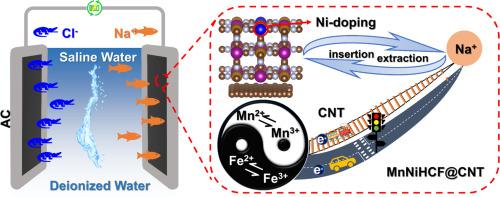通过Ni掺杂和碳纳米管复合材料实现MnHCF的结构稳定性和导电性增强,实现高效的杂化电容去离子
IF 14.3
1区 材料科学
Q1 MATERIALS SCIENCE, MULTIDISCIPLINARY
引用次数: 0
摘要
研究了在高效杂化电容去离子(HCDI)中取代过渡金属和构建导电骨架以提高稳定性和电导率的方法。本文采用一步共沉淀法成功合成了具有多氧化还原电子对和高速离子传输通道的碳纳米管复合掺镍六氰高铁酸锰三维材料(MNHCF@CNT)。合成的MNHCF5@CNT材料具有高比电容、低电荷转移电阻和优异的电化学稳定性。在40次循环后,其最高盐吸附量为71.28 mg g−1,最高盐吸附率为31.89 mg g−1 min−1,最高盐吸附量保持在98.72%。这种优异的HCDI性能主要源于MnHCF中的Ni取代形成了坚固的Ni- n键,提高了结构稳定性和离子扩散动力学。同时,通过碳纳米管建立了高效的电子传递途径,抑制了离子插入/提取过程中的体积膨胀,从而提高了材料的电导率、离子存储能力和循环稳定性。这项工作为稳定高效的PBAs电极的设计提供了可行的见解,这对于下一代海水淡化技术和硬水软化系统至关重要。本文章由计算机程序翻译,如有差异,请以英文原文为准。

Achieving enhanced structural stability and electrical conductivity of MnHCF through Ni doping and CNT composite for efficient hybrid capacitive deionization
The substitution of transition metals and construction of conductive skeleton to improve the stability and conductivity were studied for high-efficiency hybrid capacitive deionization (HCDI). Herein, the carbon nanotubes composite nickel-doped manganese hexacyanoferrate three-dimensional material (MNHCF@CNT) with multiple redox electron pairs and high-speed ion transport channels was successfully synthesized by a one-step co-precipitation method. The synthesized MNHCF5@CNT material exhibited high specific capacitance, low charge transfer resistance and excellent electrochemical stability. What is more, it achieved a high salt adsorption capacity of 71.28 mg g−1, ultrahigh maximum salt adsorption rate of 31.89 mg g−1 min−1, and maintained 98.72% of maximum salt adsorption capacity after 40 cycles. This exceptional HCDI performance primarily stems from the formation of robust Ni-N bonds via Ni substitution in MnHCF, improving the structural stability and ion diffusion kinetics. Meanwhile, efficient electron transport pathways are established through carbon nanotubes to suppress the volume expansion during the ion insertion/extraction process, thus improving the conductivity, ion storage capacity and cycle stability of the material. This work delivers actionable insights into the design of stable and highly efficient PBAs electrodes, critical for next-generation desalination technologies and hard water softening systems.
求助全文
通过发布文献求助,成功后即可免费获取论文全文。
去求助
来源期刊

Journal of Materials Science & Technology
工程技术-材料科学:综合
CiteScore
20.00
自引率
11.00%
发文量
995
审稿时长
13 days
期刊介绍:
Journal of Materials Science & Technology strives to promote global collaboration in the field of materials science and technology. It primarily publishes original research papers, invited review articles, letters, research notes, and summaries of scientific achievements. The journal covers a wide range of materials science and technology topics, including metallic materials, inorganic nonmetallic materials, and composite materials.
 求助内容:
求助内容: 应助结果提醒方式:
应助结果提醒方式:


